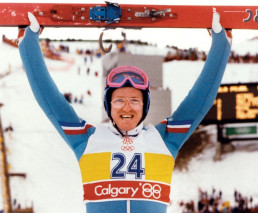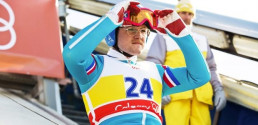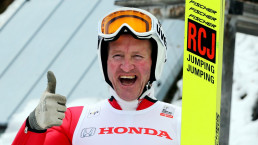Eddie “The Eagle” was the first (and, until 2002, the only) skier to represent Great Britain in an Olympic Ski Jumping event in the 1988 Calgary Winter Olympics – and he’s been a fan of uvex ever since. Although Eddie infamously finished last in both the 70m and 90m men’s ski-jump events, he broke the British national ski-jumping record, and still holds the world record for stunt jumping after soaring over 10 cars and 6 buses.
“As an Olympic ski-jumper, I know a thing or two about protective clothing and equipment. Although my ski helmet and goggles kept me safe in 1988, technology, materials and design, not to mention the effectiveness of ski gear, have all moved on enormously in the 28 years since then.

1988 compared with 2014
I have been an advocate of the expert ski equipment brand uvex since the 1988 Winter Olympics. But in the 28 years since I competed, their equipment has developed considerably in terms of technology and manufacture.
The design and production of safety equipment have been enhanced to an unrecognisable degree to give consistently high comfort and performance under extreme conditions. Ski gear is now fine-tuned for top sporting performance and to provide all the safety and protection you need out on the slopes.
Goggles
Back in 1988, I was quite short-sighted and had to wear thick glasses under my goggles, which sometimes fogged up in mid-air as I skied, making it difficult to see where I was going during take-off – a rather disconcerting experience, to say the least.

Since then I have had laser eye surgery and today, now that the latest-technology for permanent anti-fog and scratch-resistant lens coatings are used in all good ski eye wear, and goggles are designed for wearing over spectacles are widely available, such misting up is unthinkable.
Back then, the frame of my race goggle was made of PVC and the lens of cellulose acetate. Nowadays goggles are made of thermoplastic polyurethane (TPU), which is extremely strong, yet elastic, and the lenses of polycarbonate (PC), which gives them higher impact resistance and the improved optical clarity so vital during a ski-jump.
Helmets
At the time, my race helmet met the necessary safety standards. However, in comparison to today’s quality, performance, and strength, my race helmet fell far short of current ultra-lightweight head protection, which is made of much higher-tech and performance-related materials in a far larger range of attractive colours and styles.
In the eighties, my helmet was made of PC. At that time it conformed only to the German DIN standard, whereas all helmets these days must meet the much more sophisticated European EN standard. One of the materials now used for helmets is ABS, a high-impact plastic. For professional race helmets, either carbon or a fibreglass-reinforced plastic GFK is used for the outer shell, making it super-lightweight, yet stable. For the inner shell EPS is the material of choice, since it absorbs the force of impact and is far thicker than before, because of the more stringent safety standards. Alternatively, the use of a high quality thermoplastic, TPO, makes helmets much lighter and more stable, even in extremely cold temperatures. Such technological advances enable uvex to produce ultra-light weight plastic injected helmets that are aerodynamic and meet the highest possible regulation, specifically the FIS specifications for competition equipment to which athletes must comply.
I have stuck with uvex ski gear, as the products have more than proved their durability, effectiveness and worth over the years and have stayed leading-edge and at the top of their field. Robust goggles, with a large choice of lenses and styles, advanced optic technology and excellence in extreme light environments are a must these days, as are resilient helmets with innovative features.
The revolution in technology in recent years has made ski equipment much easier to use than ever before. And with technology continuing to advance, this trend should continue. These advances apply equally to personal protective equipment used in the workplace, which has seen similar improvements and enhancements. Safety clothing and equipment has developed just as much in the workplace as in the leisure and sports market, since I competed in 1988.
development of workplace safety and protection
So why do we all take care and trouble in ensuring our safety in sportswear, whether it be cycling, skiing, equestrian activities or any other extreme sport, but sometimes fail to take fully adequate steps for personal protection while at work? A professional sportsperson is, after all, working just like anybody else.
The specialist sports and industrial safety divisions of the uvex group have combined their R&D initiatives to deliver innovative products that offer outstanding protection, comfort and technology to enhance performance and safety in both sport and work.
Building and plastering
These days I have returned to my profession of general builder/plasterer, although I am still a keen skier. In my day job, safety is just as vital as in my passion for skiing – lack of safety is not an option in either field.
I was given a number of uvex industrial products to try during my day job and was impressed with the results.
For my building work, I use uvex’s tough quatro pro safety boots, their phynomic foam and wet gloves for outstanding grip and I even use them when skiing!

OBERSTDORF, GERMANY – DECEMBER 29, 2013: Former Olympian Eddie “The Eagle” Edwards attends a show jumping event on day 2 of the Four Hills Tournament Ski Jumping event at Schattenberg-Schanze on December 29, 2013 in Oberstdorf, Germany. (Photo by Alex Grimm/Bongarts/Getty Images)
I also use the uvex ultrasonic goggle, which is based on a ski goggle design, and is lightweight and very comfortable, with a panoramic, full vision lens. The soft flexible components adapt to the face and perfectly seal the eyes helping to keep out dust. These goggles would even work perfectly over prescription spectacles. The permanent lens coatings won’t wash off, and are anti-fog on the inside and scratch resistant on the outside.
Conclusion
Technology has revolutionised safety equipment for both sport and work. The two areas are very closely linked, and the importance of both cannot be over-emphasised. uvex equipment translates from sport to the workplace and functions equally well at work and at play.”
If you’re interested in learning more about of Eddie “The Eagle” Edwards, you might want to check out the 2016 biographical sports dramedy loosely based on his life: